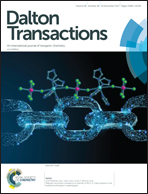Unveiling the relative stability and proton binding of non-classical Wells–Dawson isomers of [(NaF6)W18O54(OH)2]7− and [(SbO6)W18O54(OH)2]9−: a DFT study†
Abstract
Density functional theory calculations combined with the energy and building-block decomposition analyses have been carried out to investigate the structures, stability orders, redox potentials and proton binding of the six Baker–Figgis isomers (α, β, γ, α*, β* and γ*) of [(SbO6)W18O54(OH)2]9− {H2SbW18} and [(NaF6)W18O54(OH)2]7− {H2NaW18} anions at the level of PBEsol-D3/TZP. Both bonding energy and Gibbs free energy analyses exhibit that the two non-classical Wells–Dawson (WD) species behave quite differently from each other. The pyroanimonate {H2SbW18}, with a stability order of γ* > β* > α > α* > β > γ, is a non-classical WD species, while the hexafluoride {H2NaW18} (α > β > γ > γ* > β* > α*) is a transition intermediate between classical and non-classical WD types, possessing both non-classical ([XW18O60(OH)2]n−, X = I, Te and W) and classical [Si2W18O62]8− properties. Energy decomposition analyses (EDA) reveal that spatial arrangement (Ehost), host–guest fragment interaction energy (FIE), and structural distortion energy (DE) are three key factors governing the relative stability of isomers; among these, DE is always dominant, while FIE and Ehost are subordinated but are still important. Building-block decomposition analyses (BDA) disclose that the octahedral {MO6} units of the equatorial belt, particularly the staggered belt, are always more distorted than those of the two polar caps inside each structure. The theoretical redox potentials demonstrate that the oxidizing power increases with a trend of α < β < γ and α* < β* < γ* for both species, and the first redox potential is closely related to the energy level of the LUMO of each anion. Evaluation of the proton inclusion energies suggests that {H2NaW18} can only embed two protons, while {H2SbW18} may encapsulate four; the number of embedded protons is controlled by both the charge of the heteroatom X and the volume of the tetrahedral {O4}/{OF3} cavity.
![Graphical abstract: Unveiling the relative stability and proton binding of non-classical Wells–Dawson isomers of [(NaF6)W18O54(OH)2]7− and [(SbO6)W18O54(OH)2]9−: a DFT study](/en/Image/Get?imageInfo.ImageType=GA&imageInfo.ImageIdentifier.ManuscriptID=C7DT03200E&imageInfo.ImageIdentifier.Year=2017)


 Please wait while we load your content...
Please wait while we load your content...